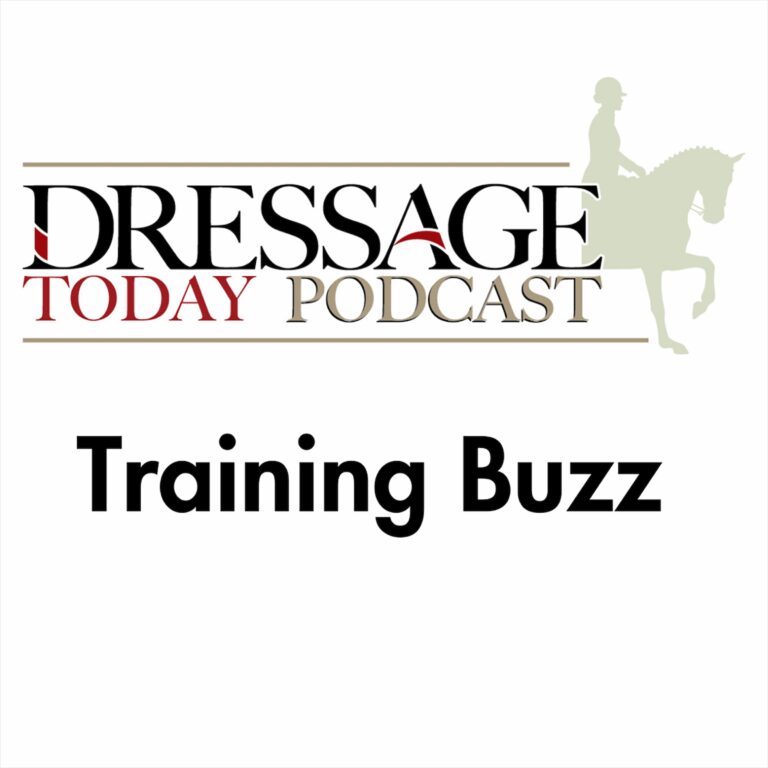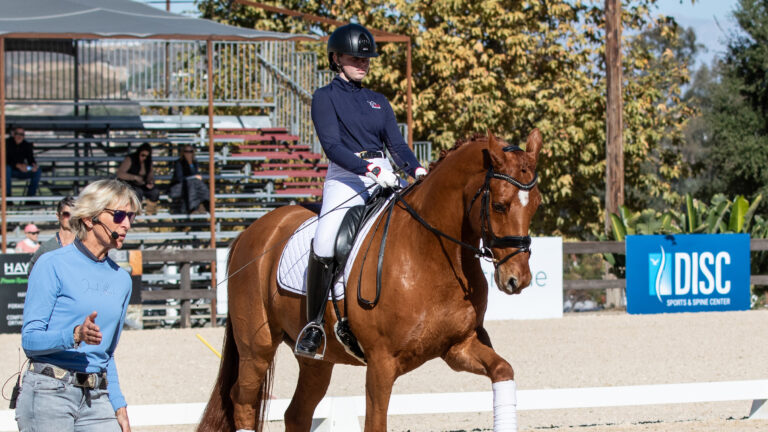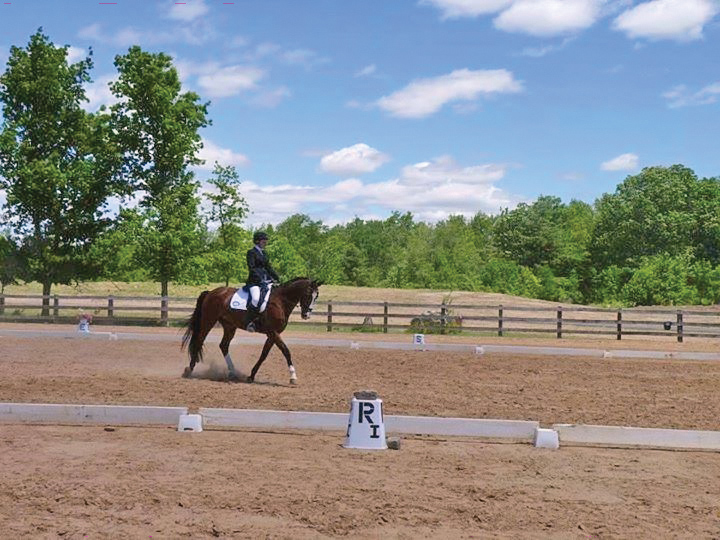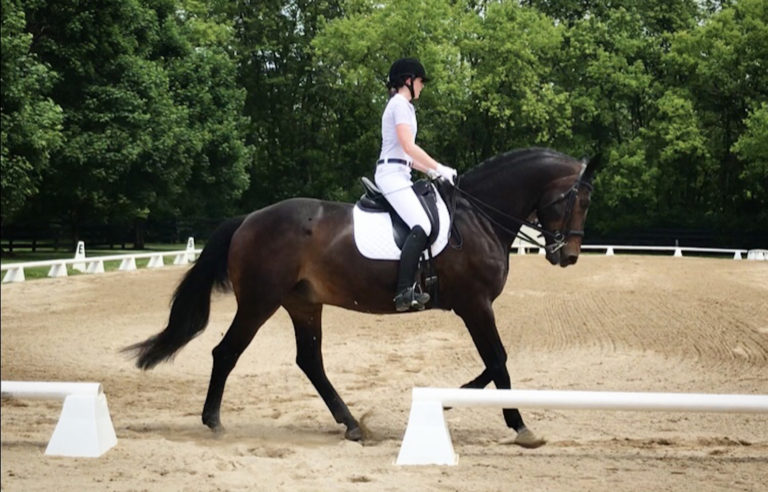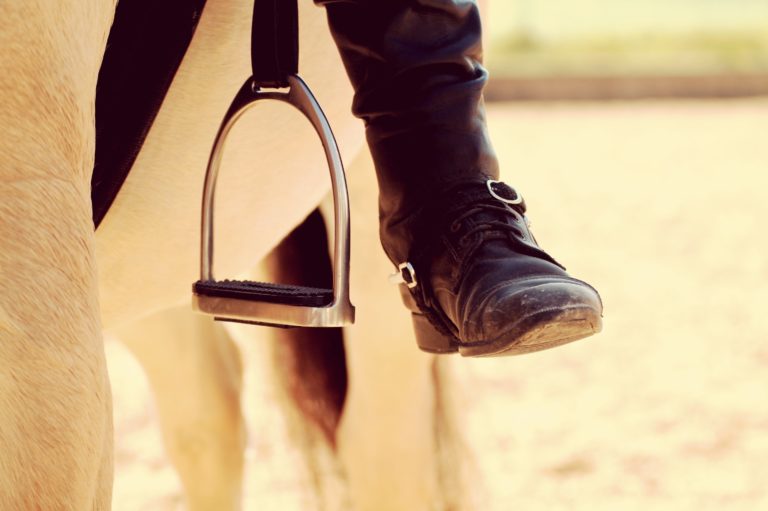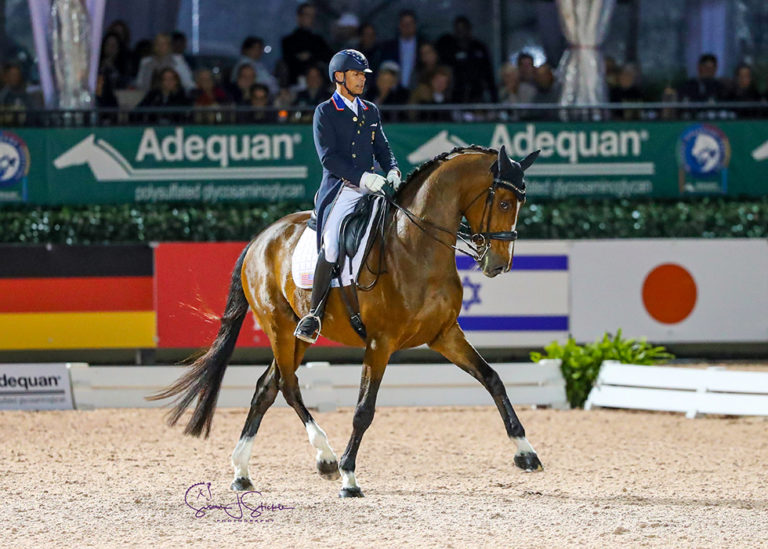The mastery of the shoulder-in is a landmark training achievement for you and your horse because the shoulder-in is the first movement that asks for collection. Up to this point in your
horse’s training, you’ve actually asked him to engage and collect with half halts. But now you have a movement that requires collection.
The shoulder-in confirms your horse’s understanding of the diagonal connection from your inside leg and seat to your outside rein and leg—a principle you’ve been steadily working toward through training and one that is the basis for all upper-level movements. At Training Level, your horse learned the bending aids on a 20-meter circle by going from the inner seat and leg to the outer aids. Then at First Level in leg yield he learned to go forward on a straight line from the inner leg into an opposing outer rein. Now at Second Level, he learns to mobilize the forehand in response to the outer rein for the first time.
The American Horse Shows Association Rule Book offers this description of the
shoulder-in: “The horse is slightly bent around the inside leg of the rider. The horse’s inside foreleg passes and crosses in front of the outside leg. The inside hind leg is placed in front of the outside leg. The horse is looking away from the direction in which he is moving. Shoulder-in, if performed in the right way, with the horse slightly bent around the inside leg of the rider and at the correct tracking, is not only a suppling movement but a collecting movement because the horse at every step must move his inside hind leg underneath his body and place it in front of the outside, which he is unable to do without lowering his inside hip.”
In practice, when shoulder-in is correct, you’ll feel your horse’s inside hind leg step under your seat. From there, he’ll balance on the outside aids, which will make his work feel easy. Through the combination of balance and power, you’ll feel his back swing, he’ll feel supple in your hand and you’ll be able to move him wherever you want to go-as if he were made of Play-Doh®.
Five Essential Prerequisites
Performing a correct shoulder-in is a large order. To ensure your success, first, we’ll look at the all-important prerequisite skills. After these are in place, performing the shoulder-in correctly is well within the grasp of most horses and riders.
Prerequisite 1: Your horse knows how to stop and go—first, in a rudimentary sense, and later after he has learned to do a half halt, so that his weight stays even or shifts a little back in the downward transition. You never want to feel that your horse’s weight shifts forward. As you half halt, your horse should come together a little and lighten. At this point, he listens and waits to see if you will prolong the half halt and ask for the halt. In the upward transition you want to feel that you still have the hind legs from the downward transition. When you close your legs to ask your horse to go forward, his hind legs thrust equally and the energy goes forward and up.
Prerequisite 2: You know how to half halt. To review:
• Your horse has the “go” achieved in Prerequisite 1.
• You quiet your seat by moving less and bringing your seat bones forward. Now your lower back is slightly round so you are sitting against and a hair behind your horse’s movement.
• At the same time, close your lower leg so that your horse’s hind legs keep stepping.
• Quiet or hold with your hand—again by moving less or not at all, but never by taking back. You’ll find that your hand doesn’t need to come back because the energy that you created by sitting into your horse engages him and puts more pressure into your hand. Now your hand just contains the energy. If you’re on a bend, you’ll have a little bit more energy in your outer hand.
• Finally, lighten your seat, relax your leg and soften with your hand. Your horse should then want to go forward. You’ll find that he maintains his impulsion and continues on in greater self-carriage.
Prerequisite 3: Your horse moves off your inner leg in leg yield into the outer rein. He draws on both reins, but goes a little bit more into the outer rein.
Prerequisite 4: Your horse understands the basic concept of the bending aids: the inside seat, leg and rein to the outside rein and leg. Specifically, he:
• gives or yields to the pressure when you supple on the inside rein.
• bends and engages in response to your inside leg and seat. Ideally, you’ll be able to use light inner aids, but use as much as you need to be effective.
• accepts contact with the outside rein, while maintaining the inside bend.
• responds to your outside leg by maintaining the bend. Your outside leg also prevents his hind legs from swinging out.
Prerequisite 5: Your horse demonstrates the diagonal connection to the outside rein on at least a 15-meter circle for shoulder-fore and a 10-meter circle for shoulder-in.
An Exercise in Straight
Before doing the shoulder-in, try this preparatory exercise, which will help you keep your horse’s hindquarters and shoulders on a straight line. Pick a line with a focal point at the far end. The focal point can be a tree, a fence post or a letter in your dressage arena. It’s even better when it can be a mirror or a person who can give you feedback. Get the feeling of straight by simply walking toward the focal point on a straight line. Ride that line without letting
a shoulder or a hind leg fall either left or right. This is difficult because all horses are stronger on one side, which makes them naturally crooked.
Step Up to Shoulder-in
With the prerequisites and preparations in hand, the steps to achieve shoulder-in should be easy.
Step 1: Establish a collected trot.
Step 2: At the end of a short side, half halt before the corner to improve your connection, compress your horse and engage his hind legs.
Step 3: Ride through the corner in bend from your inside leg to your outside rein. Check that your horse is showing flexion at the poll, positioning in the neck and bend through the body. By establishing bend and connection in the corner, you’ll set your horse up for the shoulder-in. He’ll feel supple in the hand as he moves off the inside leg and connects elastically to the outside rein. At the same time, you’ll feel the engagement of his inside hind leg under your seat.
Step 4: After the corner, half halt and make a transition to walk in the position of shoulder-in. Ask your horse to keep his haunches on the track by using more inside leg, and tell him to keep the shoulders in by keeping both of your hands slightly to the inside. Your inside seat, inside leg and rein aids will maintain the bend. Your seat also encourages your horse’s hind legs to engage, become more active and step under his center of gravity. Your outside leg reminds him to keep the bend.
Step 5: In the position of shoulder-in, ask for collected trot. Do as much shoulder-in in trot as you can without losing the balance and connection. Once you can do the shoulder-in with the walk transition, try it without. You’ll do the same steps, but you won’t hold the half halt after the corner to ask for a downward transition to walk. You’ll half halt and then lighten your seat so the transition doesn’t go through. Let your horse continue forward by maintaining
the rhythm and tempo of the trot.
Common Problems & Solutions
Shoulder-in requires a degree of strength and skill for collection that your horse hasn’t needed before. As a result, it’s common to encounter one or more of the following problems:
Your horse’s strides lose power and get short and choppy. Many riders circle or straighten their horses to regain the impulsion, but I try to make the correction in the movement: I push my horse forward while remaining in shoulder-in.
Your horse won’t bend one way and he curls around your leg going the other. Adjust your aids to compensate for his stiff or hollow side, depending on the direction you’re traveling. If your horse is stiff and difficult to bend to the left, accentuate your bending and suppling aids—the inner aids. On the other hand, if going to the right makes him curl around your inner leg, use more outside rein to prevent him from overbending, and use an active right leg to keep him forward to the bridle.
Your horse yields too much in the jaw and poll and comes behind the vertical. Keep the impulsion. Close your legs to ask your horse to step up to a supple, receiving hand.
Your horse rushes. Reinforce your half halts by repeating the downward transitions to walk or even to halt.
The haunches go out. You have angle but no bend. Your horse pushes against your inside leg with his barrel and pushes past your outside leg with his haunches. Reconfirm the bend by doing a mini-haunches-in. Then return to shoulder-in. Look for your horse’s inside eyelashes and influence him to bend from your inside leg.
Your horse bends his neck instead of his whole body. You have a “neck-in,” which is caused by too much inner rein in relation to the other aids. Ride the shoulder-in with zero bend to straighten your horse. Then reestablish bend from the inner leg.
If, at any time, you feel that you and your horse aren’t making progress in the shoulder-in, don’t worry. It happens to everyone, and the wise rider simply takes a temporary step back. Instead of shoulder-in, ask for a shoulder-fore from the corner or circle. You’ll simply ask for less angle and less bend than in the shoulder-in. Instead of making three tracks, your horse’s footfalls will make four tracks; the inside hind foot will track between the two front feet. When you’re learning or if you’re having a bad day, make your horse’s job easier by doing only 10 meters of shoulder-fore or shoulder-in. Then circle and start again. Stay in the walk until the balance is easy for both you and your horse.
Shoulder-in Benefits
Because the shoulder-in confirms your horse’s diagonal connection, it provides the suppling and engagement basics for all of the upper-level movements with bend: the travers, the half pass and the pirouette. In addition, when shoulder-in can be done equally well in both directions, you can ask your horse to straighten. So the shoulder-in also influences and enables all of the upper-level movements that are straight: collected trot and canter down the centerline, piaffe, passage and flying changes. Although you will ride these movements straight, the principle of the shoulder-in bend will still exist. Whether your horse is on the centerline or doing flying changes, you’ll want to position him very slightly left or right in the poll so he can balance on an outside rein. The versatile shoulder-in will provide you with an ample foundation.
Olympic team bronze medalist Michelle Gibson teaches and trains at Applewood Farm in Alpharetta, Georgia. Her students have enjoyed success in Florida. Michelle also conducts clinics and sells horses. Her equine partner in this article is Wodehouse, owned by Brad and Laura Thatcher.


